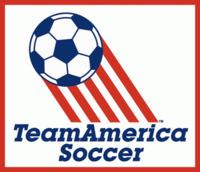Full name Team America Dissolved 1983 Chairman Robert Lifton Founded 1983 | Nickname(s) Team America Ground Capacity 55,677 | |
 | ||
League North American Soccer League Ground Robert F. Kennedy Memorial Stadium | ||
Team America was a professional version of the United States men's national soccer team which played as a franchise in the defunct North American Soccer League (NASL) during the 1983 season. The team was based in Washington, D.C., played its home games at RFK Stadium, and was intended by the NASL and the United States Soccer Federation to build fan support for the league and create a cohesive and internationally competitive national team. It did not accomplish these objectives.
Contents
A "Team America" also played an unofficial exhibition match against England in 1976, to commemorate the bicentenary of American Independence. The players were drawn from North American Soccer League clubs and included Pele and Bobby Moore. The match was played in Philadelphia, and finished 3–1 to England.
Origins
The origins of Team America came with the ascension of Howard Samuels to the positions of president and CEO of NASL on June 25, 1982. At the time, the league was on the verge of collapsing. The league had 21 teams at the end of the 1981 season, but began the 1982 season with only 14. Attendance was dropping and the league had lost its television contract. To reverse these trends, Samuels proposed turning the league’s focus away from international stars to domestic players in order to create a larger fan base. Samuels’ concept dovetailed with a desire on the part of the United States Soccer Federation (USSF) to build a more successful national team program. In order to fulfill the twin objectives of nurturing new U.S. talent to reach a greater fan base while feeding that talent into the national team, Samuels and the USSF decided to enter the national team into NASL as a franchise. At the time, U.S. players found it difficult to compete for roster spots against the foreigners who stocked most of the league’s teams. In theory, Team America would only feature U.S. players who would train with each other, fostering a sense of team cohesion which would pay dividends when the U.S. played international games. The name Team America was a reference to both the U.S. national team as well as the 1976 Team America, a team which combined U.S. national team players with the addition of several NASL international stars, which played in the 1976 U.S.A. Bicentennial Cup Tournament.
Creating the team
Samuels brought in Robert Lifton as the team owner, and in coordination with Lifton and USSF secured RFK Stadium in Washington, D.C. as the team’s home field. In January 1983, the NASL and USSF invited 39 players from the NASL, American Soccer League (ASL) and Major Indoor Soccer League (MISL) to tryouts for the 20 available roster spots. However, several top U.S. players, including Rick Davis, Jimmy McAllister, Winston DuBose, David Brcic, and Juli Veee, refused to leave their teams to play for Team America. This forced the NASL and USSF to turn to recently naturalized players and in the case of Alan Green a player who had not yet gained his citizenship. Several top U.S. players joined the team, including Chico Borja and Jeff Durgan joined Team America as did Arnie Mausser and Perry Van der Beck.
Season
Wearing a red, white and blue uniform with a horizontally striped jersey, the team began well, going 8–5, but lost 15 of its last 17 games, finishing at the bottom of the standings with a 10–20 record. (Lack of scoring punch was the biggest problem: they scored just 33 goals on the season, barely one per game and easily the worst in the league.) None of the players were named to the league's All Star team. As the team stumbled through the regular season, Samuels and Lifton became desperate. On July 27, 1983, they announced that they had approached the owners of the other NASL, as well as MISL, teams about loaning U.S. players to Team America on a game by game basis when the players' regular teams had an idle game day. However, MISL refused the NASL/USSF request for player loans, citing the NASL policy forbidding teams in that league from loaning its players to MISL. Lack of success on the field led to tensions among U.S. national team players. Some, such as Jeff Durgan, publicly criticized Rick Davis and Steve Moyers for choosing to remain with the Cosmos rather than signing with Team America. Mark Peterson, the North American Soccer League's player of the year in 1982, began the season with the Seattle Sounders, but joined Team America during the 1983 season after receiving severe criticism from other U.S. players.
Demise
The team averaged only 12,000 fans per home game, leading to severe financial losses. Additionally, USSF failed to finalize several potential marketing deals. At the end of the season, Robert Lifton pulled the plug on the franchise. Following the demise of the team, Lifton, Samuels and USSF engaged public rancour and wrangling regarding who was most responsible for this fiasco.
After the failure of Team America, Washington, D.C. was without a professional soccer club until the birth of Major League Soccer and the creation of D.C. United in 1996.
Note: Flags indicate national team as defined under FIFA eligibility rules. Players may hold more than one non-FIFA nationality.
